1984.
39 years ago I was not yet married, thus I had no children. And obviously, no grandkids. In fact, being still in my twenties, I had just gotten engaged. And I still worked at a record store. Life what it would become for me today wasn't even yet a dream.
But that was life for me during those Reagan years, when the first Jackson Civil War Muster took place. How I would've loved to have attended that first one to see the changes over the last 39 years!
But, alas, I didn't attend/participate until 20 years later, in 2004, the year I dove headfirst into the world of reenacting and living history. I remember how blown away I was seeing so many Civil War soldiers all in one area. And cannons. And the civilians. I was like a two year old looking at the world in wonder.
In fact, here are a few pictures from our very first year to be in attendance - 2004:
 |
| Jackson 2004 The 21st Michigan military. My son Tommy's the one with the long hair. |
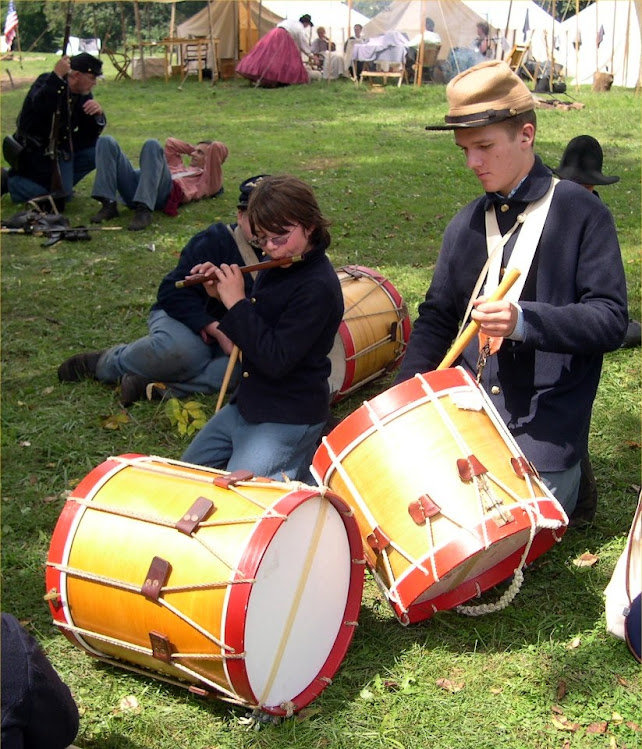 |
| Jackson 2004 My son, Robbie, too young to do military, instead played the fife with the other musicians. |
That was then - each year for Jackson went amazingly well until, unfortunately, for some odd reason things began to change; less and less reenactors showed, and then it was moved to another location.
Then covid hit...and Civil War reenacting seemed to be in grave danger due to the older participants dropping out and a lot of woke issues with many others.
This is now -
Jackson is back at its original location - Cascades Park - and reenactors are showing up in droves...excited again! Not only that but many of the whippersnapper kids who used to play in the water and run around the trees are now old enough to be soldiers. Yes---it is a younger more authentic-looking event!
After a few years of taking place at a different location and then completely shutting down due to covid, hence the reason why this is the 36th Jackson and not the 39th, and then having many of us glumly anticipate hearing that this event, like so many others, would be no more, the untiring hard work of a few folk, including Maurice Imhoff (President of the Jackson Civil War Muster Host Committee), surprised everyone in this hobby by announcing its return in 2022.
The 2022 Jackson really took everyone off guard because, well, no one was sure how it would be, and the fear of it being a shell of its former self was at the forefront of our minds.
Ahhh...on the contrary, everyone was quite impressed. Word spread about how great Jackson's return was. In fact, I witnessed it myself and was thoroughly impressed (click HERE).
So...would 2023 be as triumphant as the previous year?
Well, upon my arrival I was right off the bat very impressed with the larger amount of everything and everyone: tents, reenactors, younger reenactors, sutlers, activities, and spectators.
This told me right away that Jackson was back!
And it's back to stay!
What I have here is my "report" on how the event went this year, including loads of pictures, as usual.
Upon looking inside the program booklet, visitors and participants found that in the schedule of events, Larissa, my presentation partner, and I were one of the scheduled "events," and we gave a presentation on A Year on a Victorian Farm (or, as listed, Farming in the 1860s):
 |
| There we are! We are so very happy and proud to be able to play such a role in helping in the Jackson Civil War Muster's return! |
And here is our write up - - our biography (so to speak) from the souvenir program:
 |
| This was an honor - - ~~~ |
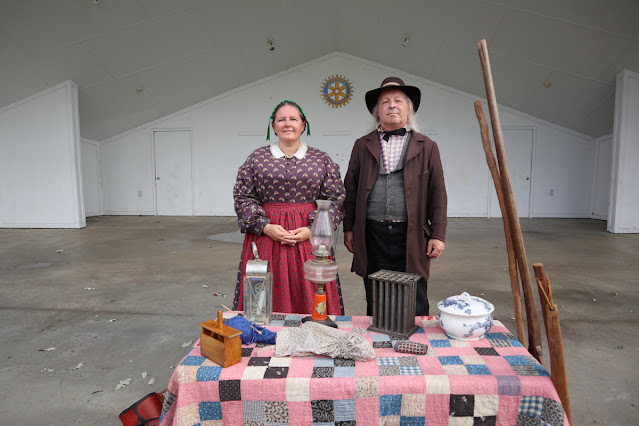 |
| Just before our presentation: All set up and ready to go! |
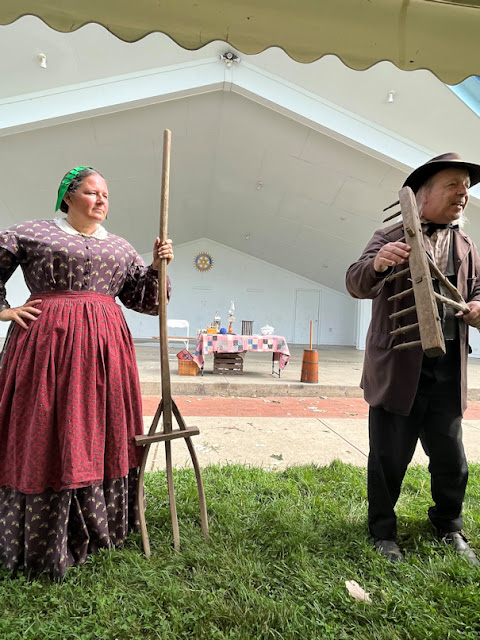 |
| Describing the homemade handmade rakes. |
Then there was the couple who not only thought Larissa & I were really married to each other, but that we were actually farmers!
Boy---were they shocked when I told them!
When you can raise that believability factor, that's what brings it all to life in the living history world.
So after our presentation I had the idea of getting our tintypes taken. Photographer, Robert Beech, thought it would be fun to do a sort of American Gothic-type image. We mostly went along with it:
 |
| Mr. Beech the tintype photographer, works his magic in capturing our likeness.  |
And here is how it turned out:
 |
| R. R. Beech - Photographer |
Robert Beech
I did not take too many battle photos for I was pretty much in only one area, which was near the artillery. However, that was very cool for I love the boomers and don't often get close-ups of them - "boomers shooting boomers" (as Larissa said lol) - and I ended up with some pretty good shots.
But, for my first time...
Though we had Civil War at Charlton Park back in July, which was a fine event indeed, there were more reenactors at Jackson - including more 21st Michigan members - so it was great to see so many I have not seen in seemingly ages.
And one person in particular I've known on Facebook, met one time in person about five years ago, but have never reenacted with:
 |
| North and South can still get along: Here we have Jenna visiting with the Confederacy's 1st Lady, Varina Davis. |
 |
| Speaking of getting along... Here we have the President of the Confederacy, Jefferson Davis with the President of the United States, Abraham Lincoln. |
As was mentioned in the program, our Jacksonburg name had been changed to Camp Harrison in honor of one of our long-time reenactors, Keith Harrison, who passed away earlier this year.
So here are a few citizens of Camp Harrison:
 |
| Jackie & Cyndi |
 |
| Joyce & Sue |
 |
| Bobby & Michael Schroeder stand with Jason Monarch. |
 |
| The 1st couple of the Confederacy, Jefferson and Varina Davis. |
 |
| The Alto's |
 |
| Vickie & Tom. Their blood runs thick in the Jackson Civil War Muster, and has for decades. |
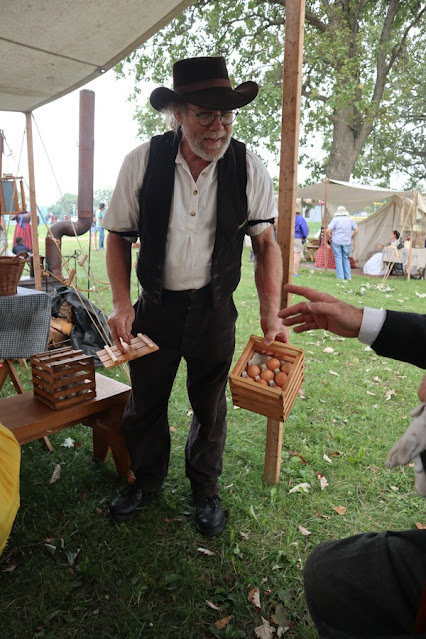 |
| Andy's the Eggman whooooo.....! |
 |
| It was good to see 1860s Charlotte again! |
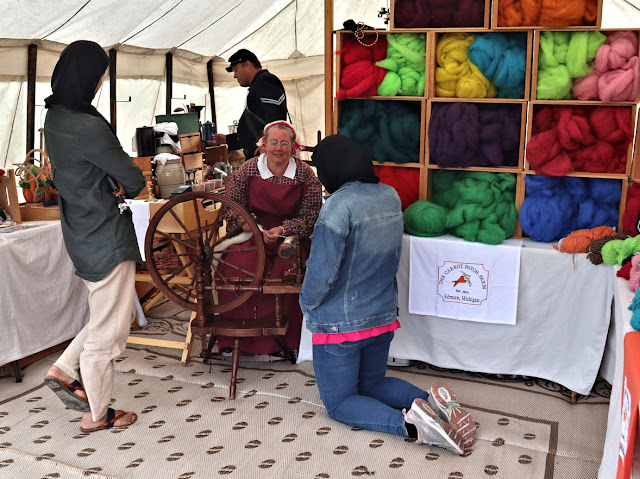 |
| Susan and her new husband Dave were there with their sutlery. |
 |
| A nice chunk of the Schroeder family was camping out. Always good to see them - and I simply cannot believe how fast their children are growing! |
 |
| The Cary clan, including their three granddaughters! |
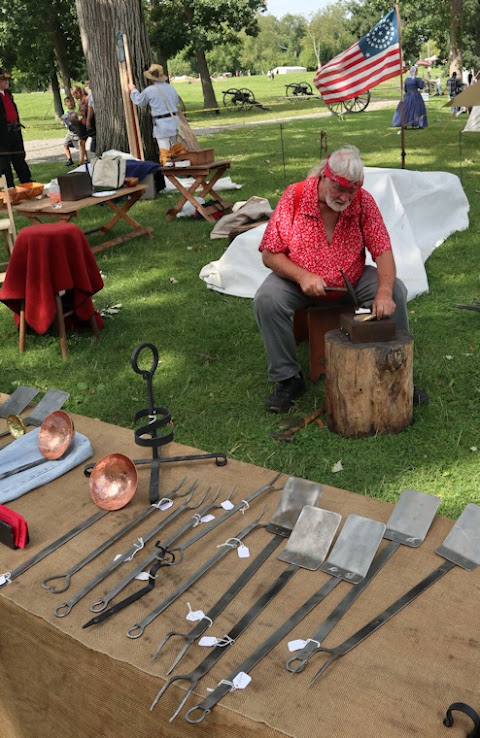 |
| The finest blacksmith in the land, no matter which century you may find him in, Richard Heinecke~ |
 |
| The Alexanders entertained with guitar-playing period music! |
 |
| Even Jim was on hand, advertising the wonderful Waterloo Farm Museum (& Dewey School Museum) |
I did not take too many battle photos for I was pretty much in only one area, which was near the artillery. However, that was very cool for I love the boomers and don't often get close-ups of them - "boomers shooting boomers" (as Larissa said lol) - and I ended up with some pretty good shots.
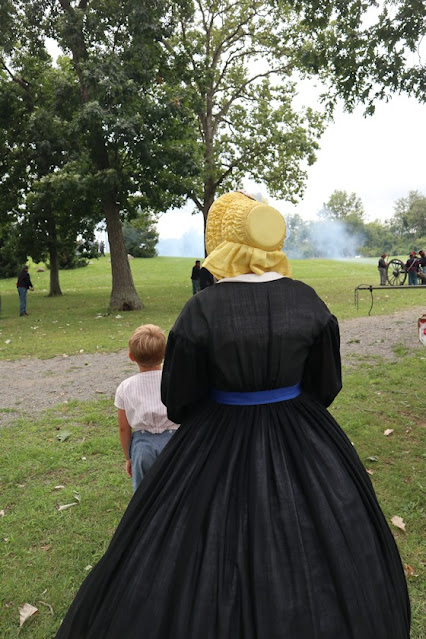 |
| Lorna and her grandson were there as well. |
 |
| Miranda eyed the excitement with some trepidation. |
 |
| Of course, with the cavalry near, the artillery needed to be extra careful on their cannon fire, which they always were. |
 |
| The cannons were fired in, I believe, two-second intervals. It was very cool to see and hear (and feel). |
 |
| I actually caught the flame shooting out of the cannon! |
 |
| How cool is this? My first time ever getting such a shot! |
 |
| The Union army soon marched off the field. |
After the battle there was something I didn't know about - a very cool medical scenario.
Unfortunately, I was not aware of it otherwise I may have been able to be more involved, so I, instead, captured the excitement for posterity:
 |
| The ladies did a beautiful job caring for the wounded men in battle. |
 |
| The "wounded" men also did a great job. |
 |
| This was a first for Jackson in quite a long while, and I was very pleased to see its return. |
 |
| We did something similar in Port Sanilac about a decade ago, and the effect really plays out well to the visitors. It's this sort of thing "they will take this home with them." |
 |
| Perhaps she could not save this young man, and it simply overwhelmed her... |
 |
| Luckily for some it could've been a flesh wound - nothing too serious. |
 |
| I played with this picture a bit and tried to give it a more ethereal effect. |
 |
| Cousin Charley the Reb, with the fancy strange-looking glasses, was there! I am so sad I did not see him! But my son, Robbie, captured him! Probably wanted his glasses - - lol |
I was only there on Saturday, but, as you can see, it was filled with bringing the past to life.
I believe everyone who was there, including visitors, would agree when I say it was one of the best Jackson events ever.
It's been a long time---welcome back!
And now, let's remove our hats and bow our heads to remember a wonderful man - a man who had the biggest heart of gold:
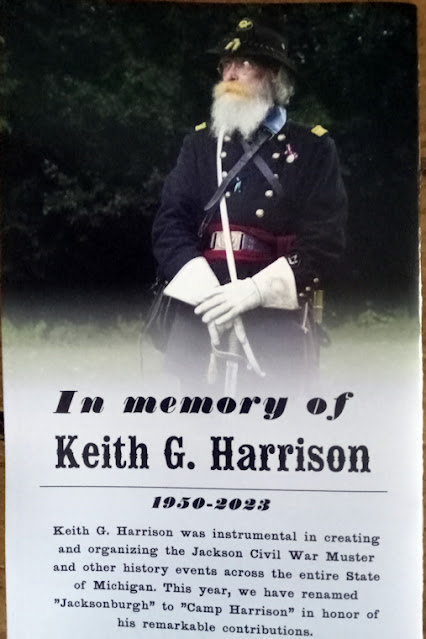 |
| A wonderful tribute to a reenactor's reenactor...to one who gave his all to this hobby and to historical preservation. We were blessed to have known him. |
This is my last reenactment for a while - - - but I won't let that stop me from time-traveling or spending time doing traditional things with past connections, for fall is nigh and that means tradition will reign!.
Stay tuned.
Until next time, see you in time.
Besides my own photos, I also used a few pictures from:
Larissa Fleishman (and her son Zane)
Robbie Giorlando (my son)
Ian Kushnir
Jenna Theissen
~~~~~~~~~~~~~~~~~~






























